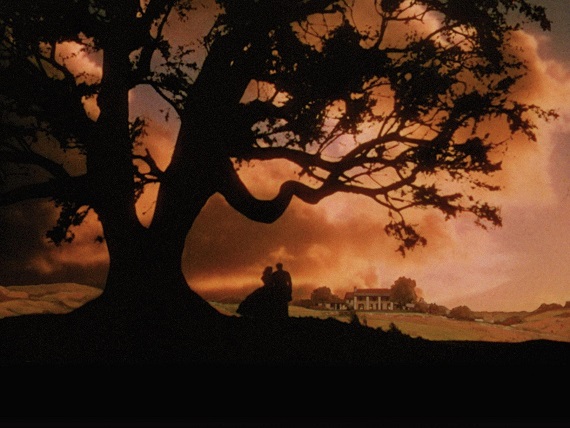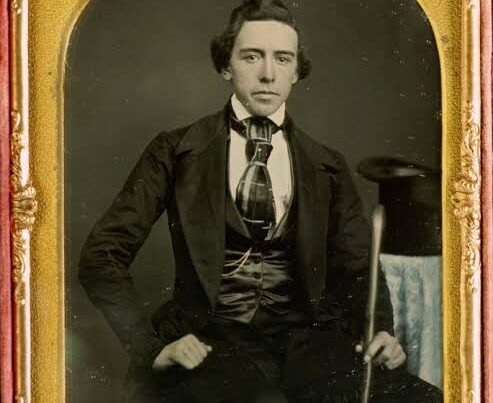
Symbols Used
** Indicates one of the more than 100 most recommended films. The order in which they appear does not reflect any ranking, only the convenience of discussion
(T) Tolerable but not among the most highly recommended
(X) Execrable. Avoid at all costs
3. The Colonial and Revolutionary South
Colonial and Revolutionary Southern history does not have a strong presence in film, unless one counts the documentaries and pseudo-documentaries that make the Revolution a New England achievement and have George Washington and Thomas Jefferson talking like they came from Ohio. The celebrated television dramas about John Adams give him an anti-slavery opinion which he did not have at that time or ever, and portray Southerners as mincing fops or honourary Yankees like George Washington in (T) The Crossing. (Will the television series (X)Sons of Liberty ever admit that Sam Adams was a slave owner?)
** The New World (2005) is well-made and about as good as we are going to get for Jamestown and Captain John Smith and Pocahontas. It brings out something of the drama and mystery of encounter with a new world.
** The Howards of Virginia (1940) is an example of a fairly sound treatment.
(T) Sangaree (1953) is Hollywoodish but does give some idea of the early tobacco era in Virginia
** The Patriot (2000), by Mel Gibson, is based (loosely) on the career of Francis Marion. It makes some good points about some of the experiences of the War of Independence, although in presenting the war in South Carolina it is more of a comic book than a reliable history.
**The Great Meadow (1931). Seeming a little innocent for the 21st century, this early talkie is an earnest effort to create for the screen Elizabeth Madox Roberts’s great novel of the early settlement of Kentucky.
WHAT COULD BE. The Revolutionary War, after it was stalemated in the North, was won in the South, by Southerners. But long ago the Revolution was made into a New England achievement and since then early American history has become irrelevant to a population that counts its origins in Ellis Island. But imagine what a fantastic thing an independent free Southern film industry could be! A real biography of Francis Marion; the British occupation and resistance in Charleston and South Carolina; the Battle of Kings Mountain; some of Simms’s Revolutionary War novels; the real life of Washington up to the point where he refused dictatorship and went home, like Cincinnatus; Morgan’s Virginia riflemen; a real life of Daniel Boone; the tragic fates of the South Carolina signers of the Declaration of Independence; the real Constitutional Convention before it was distorted by nationalist reinterpretation. There is nothing that I know of on Jefferson, beloved for generations by most Americans, except one silly piece on alleged miscegenation, (X) Jefferson in Paris.
4. The Antebellum South
Given today’s ignorant and fanatical hatred of Southern history, it is interesting how generally sympathetic treatment of antebellum society was before the 1960s.
**Jezebel (1938). Bette Davis plays an imperious Southern belle who is transformed by love into an angel of mercy. Davis won an Academy Award for this role. Like many movies, good and bad, Jezebel is set in New Orleans. Davis, although from Boston, is quite good. It is said that she was given this role as a consolation prize for losing out on Scarlett O’Hara in **Gone with the Wind. Jezebel is considered one of Davis’s best roles and one that marked her rise to stardom.
(T) Way Down South (1939). Set in antebellum Louisiana, this over-imaginative musical gives an idea of what people think the Old South was like.
(T) Reap the Wild Wind (1942). An OK John Wayne adventure set in antebellum Charleston and Florida.
(T) The Iron Mistress (1952). This film depicts the life of the great Deep South pioneer Jim Bowie as portrayed by Alan Ladd. It contains one possible version of the disputed origin of the famous knife that carries Bowie’s name and that was a weapon of choice for Southern men for several generations. Bowie’s life is somewhat fictionalized and romanticised in the style of 1950s Hollywood, but the film depicts life in Louisiana and Mississippi in the 1820s and 1830s quite well.
Two films portraying the sectional conflict of the late antebellum era are worth presenting.
**The Santa Fe Trail (1940), the story of Bleeding Kansas, Harpers Ferry, and John Brown. Among the young newly-minted Army officers involved are Jeb Stuart, played by the dashing Errol Flynn, and George Custer, played by a rather plodding Ronald Reagan. (When was his performance not plodding?) This film is a good example of the good will toward the South that characterised the American mainstream in the era it was made. (I have never been able to understand why the title has nothing to do with the movie.)
** September Dawn (2007). This is based on a true event. A party of pioneers from Arkansas heading west paused briefly in Mormon territory. For no apparent reason they were massacred (man, woman, and child) by the Mormons. A surprisingly recent glimpse into the Yankee hatred of Southerners that so pervasively characterized the 1850s. The DVD includes interviews with descendants of the Southern victims.
____________________________________________________________
Because of its deserved historical fame, the Texan War of Independence of the 1830s has attracted a lot of cinema.
(T) The Alamo (1960). Best known, or most notorious, is this John Wayne production. Wayne directed and sunk a lot of his own money into this film in the interest of well-intentioned rah-rah Americanism. But the film is more Hollywood than Alamo. Midwesterners Richard Boone, John Wayne, and Richard Widmark play the Southern heroes Houston, Crockett, and Bowie, and a Brit, Laurence Harvey, plays Travis. All too typically Hollywoodish are too much “comic relief” and the teeny bopper idol Frankie Avalon (who is said to have been frightened by snakes during the filming). The movie is Americanised at the expense of its Southern history. In fact, the Northern “Americans” who took over the U.S. half a century later in the WBTS hated and reviled the Texans who fought for their independence. I am sorry folks, but John Wayne, complete with coonskin cap and playing for humour, does not make Davy Crockett. True, the real Crockett was a famous bear hunter and humourist. He was also a well-dressed politician who owned several slaves.
**The Alamo (2004). This is a much better version of the great Texan epic. It is much more faithful to the historical event and has some real Texans, Dennis Quaid and Billy Bob Thornton as Houston and Crockett, and the Virginia-born Patrick Wilson as Travis. This film is a real epic with genuine drama and historical sense. The only thing I find wrong are two obligatory concessions to PC. The Spanish hidalgo Santa Anna is portrayed as a dumpy little mestizo that nobody would follow anywhere. The ending, when the survivor Mrs. Dickinson leaves the Alamo is falsified. Actually, she left with her little girl and a slave boy. Even the Wayne version gets this right.
** Texas Rising (2015). This series also has some feel of real history, despite a ridiculous subplot about Santa Anna’s mulatto mistress who spies for the Texans. It presents the story of the war of independence with relative accuracy, with people who really act like they belong to the time and pays attention to some of the lesser known Texan heroes like Deaf Smith and Juan Seguin. And Santa Anna is well and appropriately portrayed by Oliver Martinez.
(T) Two for Texas (2013). Based on a James Lee Burke novel, this movie is pretty good for the battle of San Jacinto.
**Gone to Texas (1986). This miniseries presents a believable picture of the life of Sam Houston (played by Sam Elliott) and the Texas War of Independence.
(T) James A. Michener’s Texas (1994). About what you can expect from a TV miniseries of its time made from a mediocre novel. Some of the accents are well done and Bowie, Travis, and Santa Anna are good. Much time is taken up by an irrelevant and unlikely romance. They keep talking about the rich land of Texas but everything is filmed on the dry and dusty plains.
____________________________________________________________
WHAT COULD BE: If there were a real Southern cinema industry what could be done for American history! How about a series on the remarkable early career of Andrew Jackson with an epic finale of the Battle of New Orleans, the date of which (January 8) was long celebrated by Americans second only to the Fourth of July? Among other things such an epic would be a demonstration of genuine Southern multiculturalism as contrasted to the phony official multiculturalism of the U.S. today. What a magnificent epic a film about Lewis and Clark could be produced by people with a real sense of history! There are many other Old South topics and personalities that would make good cinema. How about a life of Calhoun, that would educate Americans greatly about antebellum history, or a drama of the Great Triumvirate of Calhoun, Clay and Webster? But, alas, all we have is an endless procession of dubious slavery films, beginning with the plagiarized fantasy (X) Roots.
EXECRABLES: Poor imitations of Andrew Jackson have appeared in several films and Charlton Heston’s portrayal in (X) The President’s Lady (1953) fails as history. The same can be said about (X) The Far Horizons (1955), allegedly about the Lewis and Clark expedition. (X) The Jayhawkers (1959): Jayhawkers was the name applied to the vicious Republican gangs from Kansas who terrorised Missouri before and during the War Between the States. In this movie “Jayhawkers” are bad Southern bandits.
I once saw an Italian movie called Uncle Tom’s Cabin. In this film a group of Catholic priests and monks are operating a fort in the South in which they militantly protect runaway slaves. It is hard to get any more ridiculous than this. Southerners would not have tolerated such a thing for a minute. Further, despite what Catholics of today like to believe, the Church never condemned the domestic slavery of the Old South. Pio Nino expressed sympathy for the Confederacy and sent priests to combat Yankee recruitment of cannon fodder in Ireland. The Church did condemn abolitionists, most of whom were extremely anti-Catholic, as dangerous radicals.
The ad for a PBS epic on slavery tells us of “an African prince” who was “imprisoned on a Mississippi plantation” for years. It is hard for people with no understanding of the past or of human nature to grasp, but plantations were not prisons. There was no barbed wire, no guard dogs, no watchtowers, no armed jailers, and very few locks. Frequently planters slept in an unlocked house with their slaves. Nor do I think “prince” was a common term among Africans, there being no clear hereditary rule of descent for rulers, who were generally the last survivors of bloodbaths.
The black face minstrel show was a standby of American popular culture, particularly in the North where it was invented. Dozens of movies over a long period featured musical and comedy black-face material. For instance, the famous Bing Crosby’s (X) Dixie (1943). It is set in the antebellum period and is a highly fictionalized biography of Dan Emmet, the writer of the great American song “Dixie.”






